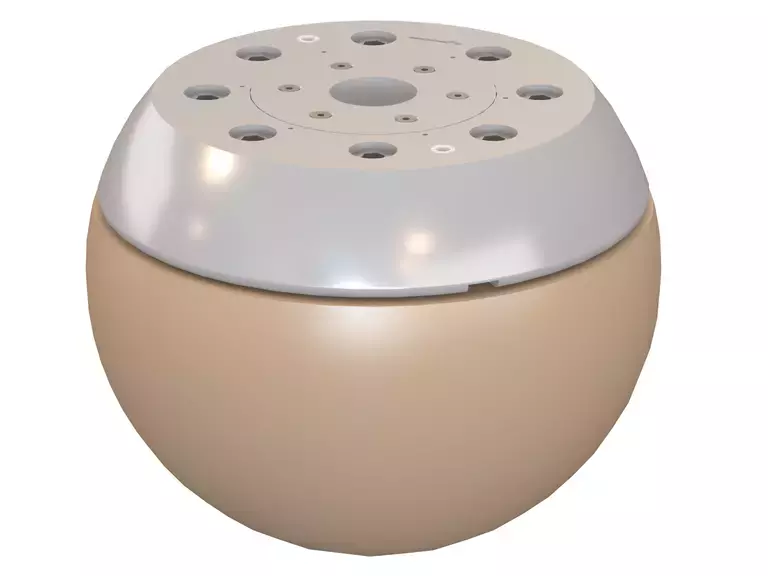






Pedestrian Headforms
- Child WG17 2.5 KG Headform D.A
- Child/Small Adult ACEA 3.5 KG Headform D.E
- Child/Small Adult GTR/JNCAP 3.5 KG Headform D.G
- Adult GTR/JNCAP 4.5 KG Headform D.F
- Adult WG17 4.8 KG Headform D.B
The pedestrian spherical headforms are a series of partial spheres designed to be launched at the windshields and hoods of cars to measure accelerations to the head of a pedestrian in a vehicle-to-pedestrian impact for calculating the HIC. The launching device is a robotic arm equipped with a magnetic or mechanical means of attachment and release.
Each headform consists of a spherical skull and cap skin with a removable flat cap plate at the back blended into the spherical shape. Provision is made for accelerometers to be mounted to the cap at the geometric center of the sphere.
Developed by Humanetics in cooperation with TNO, Netherlands Organization for Applied Scientific Research, Delft, and WG17 of the EEVC, European Enhanced Vehicle Safety Committee. Based on WG10 headforms used in EuroNCAP. WG17 is the Pedestrian Safety Working Group.
Specifications
Key Features
- Aluminum partial sphere with aluminum cap mounted at the back. The sphere is covered with a flexible elastomer (PVC) skin. Arrows on the cap define coordinate dimensions.
- The cap follows the contour of the sphere and serves to lock the skin onto the sphere.
- Provision for accelerometer mounting is provided at the geometric center of the sphere.
- The weight, moment of inertia and center of gravity of the spherical assemblies are controlled.
Applications
Measurement of head injury criteria, HIC, in vehicle-to-pedestrian impacts.
Regulations
| WHERE USED | DEFINING REGULATION |
|---|---|
| 2003/102/EEC | E/ECE/324/Rev.2/Add.126/Rev.2 E/ECE/TRANS/505/Rev.2/Add.126/Rev.2 UN R127 Annex 6 Section 3. Page 51 |
| 2005/66/EC | E/ECE/324/Rev.2/Add.126/Rev.2 E/ECE/TRANS/505/Rev.2/Add.126/Rev.2 UN R127 Annex 6 Section 3. Page 51 |
| ACEA | E/ECE/324/Rev.2/Add.126/Rev.2 E/ECE/TRANS/505/Rev.2/Add.126/Rev.2 UN R127 Annex 6 Section 3. Page 51 |
| EC 78/2009 | E/ECE/324/Rev.2/Add.126/Rev.2 E/ECE/TRANS/505/Rev.2/Add.126/Rev.2 UN R127 Annex 6 Section 3. Page 51 |
| GTR9 | E/ECE/324/Rev.2/Add.126/Rev.2 E/ECE/TRANS/505/Rev.2/Add.126/Rev.2 UN R127 Annex 6 Section 3. Page 51 |
| J-MLIT | E/ECE/324/Rev.2/Add.126/Rev.2 E/ECE/TRANS/505/Rev.2/Add.126/Rev.2 UN R127 Annex 6 Section 3. Page 51 |
| JNCAP | E/ECE/324/Rev.2/Add.126/Rev.2 E/ECE/TRANS/505/Rev.2/Add.126/Rev.2 UN R127 Annex 6 Section 3. Page 51 |
| TRIA 63-2005 | E/ECE/324/Rev.2/Add.126/Rev.2 E/ECE/TRANS/505/Rev.2/Add.126/Rev.2 UN R127 Annex 6 Section 3. Page 51 |
| UN R127 | E/ECE/324/Rev.2/Add.126/Rev.2 E/ECE/TRANS/505/Rev.2/Add.126/Rev.2 UN R127 Annex 6 Section 3. Page 51 |
Instrumentation
Simulation Models
Finite Element Model currently not available. If you are interested in this model please contact our regional sales representatives.